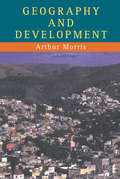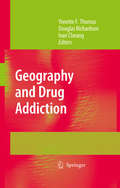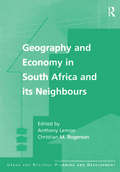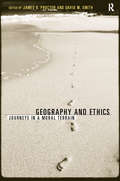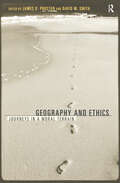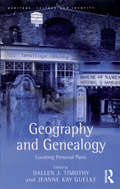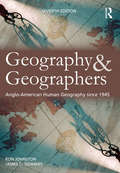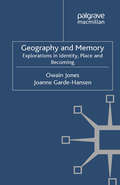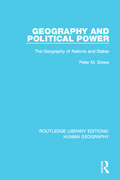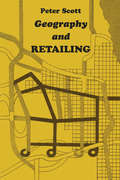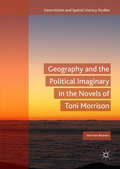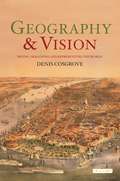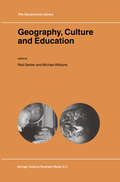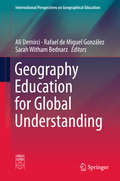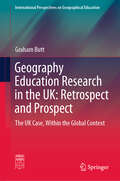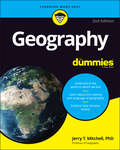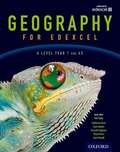- Table View
- List View
Geography And Development
by Arthur MorrisFirst published in 1998. Routledge is an imprint of Taylor & Francis, an informa company.
Geography And Development
by Arthur MorrisFirst published in 1998. Routledge is an imprint of Taylor & Francis, an informa company.
Geography and Drug Addiction
by Yonette F. Thomas Douglas Richardson Ivan CheungMaking Connections: Geography and Drug Addiction Geography involves making connections – connections in our world among people and places, cultures, human activities, and natural processes. It involves understa- ing the relationships and ‘connections’ between seemingly disparate or unrelated ideas and between what is and what might be. Geography also involves connecting with people. When I rst encountered an extraordinarily vibrant, intelligent, and socially engaged scientist at a private d- ner several years ago, I was immediately captivated by the intensity of her passion to understand how and why people become addicted to drugs, and what could be done to treat or prevent drug addiction. Fortunately, she was willing to think beyond the bounds of her own discipline in her search for answers. Our conversation that evening, which began with her research on fundamental biochemical processes of drug addiction in the human body, evolved inevitably to an exploration of the ways in which research on the geographical context of drug addiction might contribute to the better understanding of etiology of addiction, its diffusion, its interaction with geographically variable environmental, social, and economic factors, and the strategies for its treatment and prevention. This fascinating woman, I soon learned, was Nora Volkow, the Director of the National Institute on Drug Abuse as well as the granddaughter of Leon Trotsky.
Geography and Economy in South Africa and its Neighbours (Urban and Regional Planning and Development Series)
by Christian M. RogersonThe dismantling of the apartheid regime in South Africa caused massive transformation in both geographical and economic terms, not only in this country but also in the region as a whole. As the post-apartheid government enters its second term, this captivating volume assesses its progress in unravelling the geography of apartheid, both in South Africa itself and in its relationships with other countries in Southern Africa and Africa. It also considers the ways in which South Africa, now that it is no longer a pariah state, has begun to position itself within the current global economy. Examining South Africa’s land and agriculture, mining and minerals, manufacturing, tourism, corporate finance, the labour market and transport, the volume discusses the challenges of balancing growth and redistribution, the extent and nature of progress, change and relationships within the regional and global economy. A compelling investigation into the economics of South Africa's neighbouring states in relation to their natural resources, colonialism and inter-relationships with themselves and with South Africa leads to a focus on the region as a whole and its relations with the global economy.
Geography and Economy in South Africa and its Neighbours (Urban and Regional Planning and Development Series)
by Christian M. RogersonThe dismantling of the apartheid regime in South Africa caused massive transformation in both geographical and economic terms, not only in this country but also in the region as a whole. As the post-apartheid government enters its second term, this captivating volume assesses its progress in unravelling the geography of apartheid, both in South Africa itself and in its relationships with other countries in Southern Africa and Africa. It also considers the ways in which South Africa, now that it is no longer a pariah state, has begun to position itself within the current global economy. Examining South Africa’s land and agriculture, mining and minerals, manufacturing, tourism, corporate finance, the labour market and transport, the volume discusses the challenges of balancing growth and redistribution, the extent and nature of progress, change and relationships within the regional and global economy. A compelling investigation into the economics of South Africa's neighbouring states in relation to their natural resources, colonialism and inter-relationships with themselves and with South Africa leads to a focus on the region as a whole and its relations with the global economy.
Geography and Ethics: Journeys in a Moral Terrain
by James D. Proctor David M. SmithThis book represents a landmark exploration of the common terrain of geography and ethics. Drawing together specially commissioned contributions from distinguished geographers across the UK, North America and Australasia, the place of geography in ethics and of ethics in geography is examined through wide-ranging, thematic chapters.Geography and Ethics is divided into four sections for discussion and exploration of ideas: Ethics and Space; Ethics and Place; Ethics and Nature and Ethics and knowledge, all of which point to the rich interplay between geography and moral philosophy or ethics.
Geography and Ethics: Journeys in a Moral Terrain
by James D. Proctor David M. SmithThis book represents a landmark exploration of the common terrain of geography and ethics. Drawing together specially commissioned contributions from distinguished geographers across the UK, North America and Australasia, the place of geography in ethics and of ethics in geography is examined through wide-ranging, thematic chapters.Geography and Ethics is divided into four sections for discussion and exploration of ideas: Ethics and Space; Ethics and Place; Ethics and Nature and Ethics and knowledge, all of which point to the rich interplay between geography and moral philosophy or ethics.
Geography and Genealogy: Locating Personal Pasts
by Jeanne Kay GuelkeGenealogy has become a widely popular pursuit, as millions of people now research their family history, trace their forebears, attend family reunions and travel to ancestral home sites. Geographers have much to contribute to the serious study of the family history phenomenon. Land records, maps and even GIS are increasingly used by genealogical investigators. As a cultural practice, it encompasses peoples' emotional attachments to ancestral places and is widely manifest on the ground as personal heritage travel. Family history research also has significant potential to challenge accepted geographical views of migration, ethnicity, socio-economic class and place-based identities. This volume is possibly the first ever book to address the geographical and scholarly aspects of this increasingly popular social phenomenon. It highlights tools and information sources used by geographers and their application to family history research. Furthermore, it examines family history as a socio-cultural practice, including the activities of tourism, archival research and DNA testing.
Geography and Genealogy: Locating Personal Pasts
by Jeanne Kay GuelkeGenealogy has become a widely popular pursuit, as millions of people now research their family history, trace their forebears, attend family reunions and travel to ancestral home sites. Geographers have much to contribute to the serious study of the family history phenomenon. Land records, maps and even GIS are increasingly used by genealogical investigators. As a cultural practice, it encompasses peoples' emotional attachments to ancestral places and is widely manifest on the ground as personal heritage travel. Family history research also has significant potential to challenge accepted geographical views of migration, ethnicity, socio-economic class and place-based identities. This volume is possibly the first ever book to address the geographical and scholarly aspects of this increasingly popular social phenomenon. It highlights tools and information sources used by geographers and their application to family history research. Furthermore, it examines family history as a socio-cultural practice, including the activities of tourism, archival research and DNA testing.
Geography and Geographers: Anglo-American human geography since 1945
by Ron Johnston James D. SidawayGeography and Geographers continues to be the most comprehensive and up-to-date overview of human geography available. It provides a survey of the major debates, key thinkers and schools of thought in the English-speaking world, setting them within the context of economic, social, cultural, political and intellectual changes. It is essential reading for all undergraduate geography students.It draws on a wide reading of the geographical literature and addresses the ways geography and its history are understood and the debates among geographers regarding what the discipline should study and how.This extensively updated seventh edition offers a thoroughly contemporary perspective on human geography for new and more experienced students alike.
Geography and Geographers: Anglo-American human geography since 1945
by Ron Johnston James D. SidawayGeography and Geographers continues to be the most comprehensive and up-to-date overview of human geography available. It provides a survey of the major debates, key thinkers and schools of thought in the English-speaking world, setting them within the context of economic, social, cultural, political and intellectual changes. It is essential reading for all undergraduate geography students.It draws on a wide reading of the geographical literature and addresses the ways geography and its history are understood and the debates among geographers regarding what the discipline should study and how.This extensively updated seventh edition offers a thoroughly contemporary perspective on human geography for new and more experienced students alike.
Geography and Memory: Explorations in Identity, Place and Becoming (Palgrave Macmillan Memory Studies)
by Owain Jones Joanne Garde-HansenThis collection shifts the focus from collective memory to individual memory, by incorporating new performative approaches to identity, place and becoming. Drawing upon cultural geography, the book provides an accessible framework to approach key aspects of memory, remembering, archives, commemoration and forgetting in modern societies.
Geography and Political Power: The Geography of Nations and States (Routledge Library Editions: Human Geography)
by Peter M. SloweFocusing on the relationship between geography and power, this book, originally published in 1990, isolates five sources of political power – might, right, nationhood, legality and legitimacy – and demonstrtes the centrality of geography to the argument of each case. The author stresses the value of geographical expertise to political decision-making and illustrates this through the use of case—studies. His analysis of the sources of power goes deep into an understanding of politics and explores the implications for geography of political thought.
Geography and Political Power: The Geography of Nations and States (Routledge Library Editions: Human Geography #18)
by Peter M. SloweFocusing on the relationship between geography and power, this book, originally published in 1990, isolates five sources of political power – might, right, nationhood, legality and legitimacy – and demonstrtes the centrality of geography to the argument of each case. The author stresses the value of geographical expertise to political decision-making and illustrates this through the use of case—studies. His analysis of the sources of power goes deep into an understanding of politics and explores the implications for geography of political thought.
Geography and Retailing
by Peter ScottAn important contribution to our understanding of the distribution of retail activities, particularly within cities, this book provides a critical review of the literature on the subject. It points out the major general propositions concerning retailing from the geographical point of view, and identifies key research problems, which need to be examined in order to push forward the frontiers of this sub field of economic geography. It presents a major critique of the central-place model, which has come to hold an important place in the methodology of economic geography, and clearly and decisively shows the model to be static, deterministic, retrospective and of little value for predictive purposes.
Geography and Retailing
by Peter ScottAn important contribution to our understanding of the distribution of retail activities, particularly within cities, this book provides a critical review of the literature on the subject. It points out the major general propositions concerning retailing from the geographical point of view, and identifies key research problems, which need to be examined in order to push forward the frontiers of this sub field of economic geography. It presents a major critique of the central-place model, which has come to hold an important place in the methodology of economic geography, and clearly and decisively shows the model to be static, deterministic, retrospective and of little value for predictive purposes.
Geography and the Political Imaginary in the Novels of Toni Morrison (Geocriticism and Spatial Literary Studies)
by Herman BeaversThis book examines Toni Morrison’s fiction as a sustained effort to challenge the dominant narratives produced in the white supremacist political imaginary and conceptualize a more inclusive political imaginary in which black bodies are valued. Herman Beavers closely examines politics of scale and contentious politics in order to discern Morrison's larger intent of revealing the deep structure of power relations in black communities that will enable them to fashion counterhegemonic projects. The volume explores how Morrison stages her ruminations on the political imaginary in neighborhoods or small towns; rooms, houses or streets. Beavers argues that these spatial and domestic geographies are sites where the management of traumatic injury is integral to establishing a sense of place, proposing these “tight spaces” as sites where narratives are produced and contested; sites of inscription and erasure, utterance and silence.
Geography and the Political Imaginary in the Novels of Toni Morrison
by Herman BeaversThis book examines Toni Morrison’s fiction as a sustained effort to challenge the dominant narratives produced in the white supremacist political imaginary and conceptualize a more inclusive political imaginary in which black bodies are valued. Herman Beavers closely examines politics of scale and contentious politics in order to discern Morrison's larger intent of revealing the deep structure of power relations in black communities that will enable them to fashion counterhegemonic projects. The volume explores how Morrison stages her ruminations on the political imaginary in neighborhoods or small towns; rooms, houses or streets. Beavers argues that these spatial and domestic geographies are sites where the management of traumatic injury is integral to establishing a sense of place, proposing these “tight spaces” as sites where narratives are produced and contested; sites of inscription and erasure, utterance and silence.
Geography and Vision: Seeing, Imagining and Representing the World (International Library of Human Geography)
by Denis CosgroveVision and visual imagery have always played a central role in geographical understanding, and geographical description has traditionally sought to present its audience with rich and compelling visual images, be they the elaborate cosmographic images of seventeenth century Europe or the computer and satellite imagery of modern geographical information science. Yet the significance of images goes well beyond the mere transcription of spatial and environmental facts and today there is a marked unease among some geographers about their discipline's association with the pictorial. The expressive authority of visual images has been subverted, shifting attention from the integrity of the image itself towards the expression of truths that lie elsewhere than the surface. In Geography and Vision leading geographer Denis Cosgrove provides a series of personal reflections on the complex connections between seeing, imagining and representing the world geographically. In a series of eloquent and original essays he draws upon pictorial images - including maps, sketches, cartoons, paintings, and photographs - to explore and elaborate upon the many and varied ways in which the vast and varied earth, and at times the heavens beyond, have been both imagined and represented as a place of human habitation. Ranging historically from the sixteenth century to the present day, the essays include reflections upon geographical discovery and Renaissance landscape; urban cartography and utopian visions; ideas of landscape and the shaping of America; wilderness and masculinity; conceptions of the Pacific; and the imaginative grip of the Equator. Extensively illustrated, this engaging work reveals the richness and complexity of the geographical imagination as expressed over the past five centuries. It will appeal to all scholars with an interest in geography, history, art, landscape, culture and environment.
Geography, Culture and Education (GeoJournal Library #71)
by MichaelWilliams RodGerberThe aim of this book is to inject more intercultural understanding and education into people's lives. This is achieved by focusing on key aspects such as geography and culture, geography and citizenship, pedagogic implications and future directions for inter-cultural learning, understanding, and education. This publication demonstrates how the study of geography can assist people in different social and cultural groups to sustain their lifeworlds, and improve them for future generations of citizens.
Geography Education for Global Understanding (International Perspectives on Geographical Education)
by Ali Demirci Rafael de Miguel González Sarah Witham BednarzThis book presents the core concepts of geographical education as a means of understanding global issues from a spatial perspective. It treats education, supported by high standards, approaches, methodologies, and resources, as essential in exploring the interactions of the world’s human and environmental systems at local, regional, and global scales embedded in the nature of the discipline of geography. It covers topics such as climate change, sustainable development goals, geopolitics in an uncertain world, global crisis, and population flows, which are of great interest to geography researchers and social sciences educators who want to explore the complexity of contemporary societies.Highly respected scholars in geography education answer questions on key topics and explain how global understanding is considered in K-12 education in significant countries around the globe. The book discusses factors such as the Internet, social media, virtual globes and other technological developments that provide insights into and visualization – in real time – of the intensity of relationships between different countries and regions of the earth. It also examines how this does not always lead to empathy with other political, cultural, social and religious values: terrorism threats and armed conflicts are also essential features of the global world. This book opens the dialogue for global understanding as a great opportunity for teachers, educators, scholars and policy makers to better equip students and future citizens to deal with global issues.
Geography Education Research in the UK: The UK Case, Within the Global Context (International Perspectives on Geographical Education)
by Graham ButtThis book provides a unique assessment of the development of research in geography education and its future prospects, offering a challenging critique of subject-based education research, with particular reference to geography education across a range of different jurisdictions. It covers a range of topics, including the changing role of research in geography education; the relationship between education research and professional practice, with special reference to geography education research; the place of academic subject knowledge in geography education research; critiques of the functions of research in geography education; and the key issues for education policy and policymakers concerning educational research at national and international levels.Importantly, in a period marked by radical change for education research and researchers, the book offers a timely appraisal of possible ways forward for geography education research. Addressing the needs of academics, research students, policymakers, and education practitioners who undertake, use or shape the future of research in geography education, it comprehensively explores the forces that have driven the development of geography education research and pedagogy. Further, by positioning its analysis in the context of education policy debates in the UK, and further afield, it assesses the role and function of research in education, and offers an outlook on its future. This book is essential reading for all those who wish to understand the sporadic and increasingly uncertain development of subject-based research in education
Geography For Dummies
by Jerry T. MitchellThe whole world in the palm of your hand Ever wonder how you can have a rainforest on one side of a mountain and a desert on the other? Or zoom around the globe with Google Maps and wonder how everything got to where it is now? The answer is…geography. In Geography For Dummies, you’ll discover that geography is more than just cool trivia—it explains tons about the world around us. From understanding the basics—like how to read maps and geographic coordinates—to learning about how the continents got to their current positions, you’ll learn fascinating things about the planet’s people, cities, resources, and more. In this book, you’ll discover: How geographers make and use maps to understand and tell useful stories about the earth How weather and climate shape the planet, impact the water supply, and change landscapes How humans use (and overuse) the planet we live on to our advantageGeography For Dummies is an incredible exploration of our planet and the people who live on it. This book takes a huge subject and makes it accessible for the rest of us!
Geography For Dummies
by Jerry T. MitchellThe whole world in the palm of your hand Ever wonder how you can have a rainforest on one side of a mountain and a desert on the other? Or zoom around the globe with Google Maps and wonder how everything got to where it is now? The answer is…geography. In Geography For Dummies, you’ll discover that geography is more than just cool trivia—it explains tons about the world around us. From understanding the basics—like how to read maps and geographic coordinates—to learning about how the continents got to their current positions, you’ll learn fascinating things about the planet’s people, cities, resources, and more. In this book, you’ll discover: How geographers make and use maps to understand and tell useful stories about the earth How weather and climate shape the planet, impact the water supply, and change landscapes How humans use (and overuse) the planet we live on to our advantageGeography For Dummies is an incredible exploration of our planet and the people who live on it. This book takes a huge subject and makes it accessible for the rest of us!
Geography for Edexcel A Level Year 1 and AS Student Book (PDF)
by Bob Digby Lynn Adams Russell Chapman Catherine HurstPlease note this title is suitable for any student studying: Exam Board: Edexcel Level: A Level Year 1 and AS Subject: Geography First teaching: September 2016 First exams: June 2018 A student-friendly and engaging textbook for the Edexcel GCE A Level Year 1 and AS specifications. It has been specially written to match the demands of the 2016 specifications and has been endorsed for Edexcel. The coverage of key geographical concepts and processes is accessible and clear, and all students will be engaged by the interesting, up-to-date examples and case studies - while the rigour, detail, and depth required by the specifications is retained throughout. Clearly-written objectives open each section, setting out for students what they need to learn, and high-quality photos, maps, and diagrams aid explanations. Motivating activities, exam-style questions, and coverage of the required skills are strong features. The book is completed with a glossary for each chapter and a full index. Answer guidance for the activities is available on Kerboodle (school purchase only).
